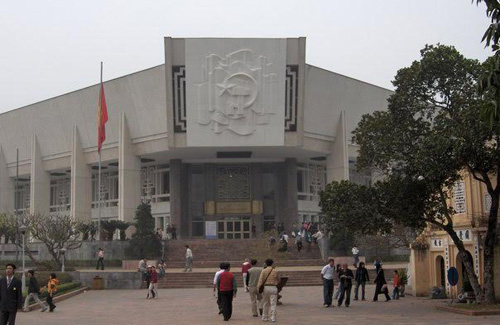
Three decades have passed since Vietnam first embarked on the process of economic opening and reform known as Doi Moi, or “Renovation.” At the 12th National Congress of the Vietnamese Communist Party which concluded last week, more than 1,500 delegates representing 4.5 million members from across the country took stock of these last 30 years and set an agenda for the next period of growth and development.
Meeting under the theme of “Solidarity – Democracy – Discipline – Renovation,” the party renewed its commitment to advancing Vietnamese living standards and continuing the construction of a socialist-oriented market economy.
This model differs from the Soviet-inspired archetype of the centrally-planned economy that Vietnam followed up until the late 1980s which was characterized by almost total state ownership and government-determined pricing and production quotas. The Vietnamese economy today combines private, social, cooperative, and state ownership forms and has the declared aim of developing the country’s productive forces to a high level while preparing the way for a future transition to a socialist economy.
Economic allocation and production decisions are largely determined by market conditions, but major public investment priorities are set by the government and the strategic sectors of the economy remain under state guidance. This mixed approach shares characteristics with the socialist market economy model followed by China since 1978 and has produced similarly remarkable achievements for Vietnam.
Since 1986, the extreme poverty rate in the country has dropped from more than 50 percent to only three percent today. In human terms, this means more than twenty million people have been lifted out of poverty. Per capita incomes, meanwhile, have soared from only $100 USD to over $2,000 USD in 2015. This has pushed the country from being one of the world’s poorest to the lower middle income ranks internationally.
Impressive on their own, the scale of these achievements becomes even more pronounced when set within the challenging context of Vietnam’s post-independence history. For much of the twentieth century, Vietnam was forced to spend too much of its limited resources and too many of its people’s lives fighting off foreign occupiers and invaders. Japanese imperial forces were forced from the country in 1945 only to be almost immediately replaced by returning French colonial armies.
The country then remained divided for the next thirty years between an independent north and a southern government propped up by outside forces. In 1954, the French were defeated at Dien Bien Phu, but American forces quickly took their place. U.S. involvement in Vietnam then dragged on until 1975, costing the lives of over three million Vietnamese and more than 58,000 Americans.
The effects of war still plague Vietnam to this day. For instance, the chemical weapon Agent Orange was sprayed by U.S. military forces over much of the Vietnamese countryside during the war with the aim of causing defoliation and cutting off food supplies. The cancers, birth defects, and other long-term health problems it caused continue to eat up valuable financial resources.
All of these extra challenges and setbacks come on top of the typical problems that face every developing country. Despite all of these headwinds, however, Vietnam has pushed ahead and has rapidly taken a position among the leading economies in Southeast Asia. Last week’s party congress set its aim on building upon the strides the country has already made.
The congress, which meets every five years, is the central event in Vietnam’s political calendar. In addition to setting broad outlines for the country’s socioeconomic agenda, it also elects the leadership that will be responsible for overseeing the execution of the goals set at the meeting.
The leadership slate elected by the party delegates represented a mix of continuity and renewal. General Secretary Nguyen Phu Trong was re-elected to a second term as head of the central committee, despite the fact that, at age 71, he is past the party’s mandatory retirement age. This rule was temporarily lifted and Trong was urged to stay on in order to see the party and the country through the next few years, which are expected to be challenging for Vietnam.
Trong humbly told reporters at the congress, “My age is high, my health is limited, and my knowledge is limited. I asked to step down, but because of the responsibility assigned by the party I have to perform my duty.”
The current Minister of Security, Tran Dai Quang, was nominated as the party’s choice to take over for President Truong Tan Sang when the National Assembly meets in June. Deputy Prime Minister Nguyen Xuan Phuc, meanwhile, was put forward to succeed outgoing Prime Minister Nguyen Tan Dung.
In addition to experienced hands like these, the new party central committee also includes many leaders from the next generation. The congress selected a leadership that includes a mix of senior, mid-level, and younger officials. More than a quarter of the 200 central committee members are under the age of 50, while the youngest member of the incoming political bureau is only 45 years old.
Additionally, the elections broke new ground on the gender equality front. Three women members were elected to the political bureau, the highest female representation in the top leadership body to date.
The final resolution adopted by the congress predicts the coming period to remain a challenging one, as the country continues to recover from the global recession and faces uncertain conditions in the economies of several of its biggest trading partners, such as China and the United States.
Though the recent recession hit Vietnam’s export-oriented economy hard and drove growth rates down to 5.5 percent from their 2000s levels of around seven percent, the outlook for the next five-year plan sees a return to 6.5 – seven percent in the period 2016-2020. A GDP per capita goal of $3,200 – 3,500 USD was also set for 2020.
The congress pledged to give renewed emphasis to reducing the remaining poverty in the country, especially among ethnic minorities. It also declared its intention to continue perfecting the model of the socialist-oriented market economy, including efficiency improvements in state-owned enterprises, reform of the banking sector which has long been plagued by non-performing loans, and control over inflation.
On the political front, the Communist Party leadership signaled its commitment to extending democratization and fighting corruption and bureaucratic hurdles within the state and party. In his keynote address, President Sang declared the 12th congress to be “the congress of solidarity, democracy, and reform.”
After 30 years of transformational change and opening to the outside world, Vietnam has looked back on its achievements at this congress and is now poised to continue moving ahead with the development of its socialist-oriented model. It does so, however, in a world still very much dominated by global capital and where the instabilities of the neoliberal, finance-led model of capitalism constrain every attempt at building alternatives.
As another socialist experimenter in the early 20th century once said, when a revolution is surrounded by capitalist countries, it will be “forced to seek highly complex forms of relationships.” Vietnam remains in just such a transitional stage. How its people and leadership navigate the challenges facing their country in the years ahead will be a story all progressives should follow closely.
Photo: The Ho Chi Minh Museum in Hanoi. | C.J. Atkins/PW

MOST POPULAR TODAY

Zionist organizations leading campaign to stop ceasefire resolutions in D.C. area


High Court essentially bans demonstrations, freedom of assembly in Deep South

Afghanistan’s socialist years: The promising future killed off by U.S. imperialism

Communist Karol Cariola elected president of Chile’s legislature






Comments